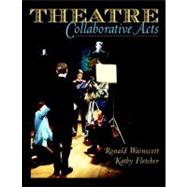
Note: Supplemental materials are not guaranteed with Rental or Used book purchases.
Purchase Benefits
Every chapter contains “For Further Exploration,” “Questions and Activities,” and “Key Terms and Concepts.”
ACT I. THEATRE AND ITS AUDIENCE.
1. Cultural Colaboration: Theatre and Society.
Theatre as Entertainment and Art.
The Social Functions of Theatre.
Social Control of Theatre.
Cultural Context and Personal Experience.
2. Experiencing Theatre: Collaboration of Actor, Audience, and Space.
The Audience.
The Nature of Acting.
From Play to Production.
Space.
Theatre and Transformation.
3. Analyzing Theatre: Thinking and Writing About Live Performance.
Theatre, Film, and Television.
Analyzing Production.
Thinking About Actor Performances.
Thinking About Space and Design.
Understanding Style.
Evaluating Production.
The Role of the Critic.
Writing About Production.
When It All Works.
4. Understanding the Play: A Theatrical Blueprint.
Character.
Thought.
Language.
Music.
Spectacle.
5. Interpreting the Play: Understanding Genre, Reading, and Writing.
Dramatic Genre.
Reading a Play.
Writing About a Play.
6. Producing the Play: Connecting Theatre and Audience.
Theatrical Choice in North America.
The Role of the Producer.
The Economics of Theatre.
Photo Essay: Theatrical Diversity.
ACT II. THEATRE: COLLABORATION IN HISTORY.
7. Foundations: Classical Theatrical Forms.
Classical Greece.
Classical Rome.
Classical India.
Medieval Europe.
Classical China.
Classical Japan.
8. Reinterpretations: Europe Rediscovers the Western Classics.
The Italian Renaissance.
Elizabethan England.
The Spanish Golden Age.
Seventeenth-Century France.
Restoration England.
Eighteenth-Century Europe and the Americas.
9. Revolutions: Romanticism to Postmodern.
Romanticism.
Nineteenth-Century Melodrama.
Nineteenth-Century Realism and Naturalism.
The Avant-Garde from the Late Nineteenth Century to the 1960s.
Twentieth-Century Popular Theatre.
The Recent Avant-Garde and Postmodern Experiment.
Timeline.
ACT III. COLLABORATION IN ART AND PRACTICE.
10. The Director: Vision and Leadership.
Has Someone Always Been in Charge?
Interpretation.
Developing Concept.
Communicating and Managing the Artistic Vision.
Collaborating with the Playwright.
Collaborating with Actors.
Collaborating with Stage Management.
The Rehearsal Process.
Opening the Production.
The Artistic Director.
11. The Actor: From Mask to Contemporary Performance.
Development of the Actor.
The Actor's Work.
12. The Playwright: Imagination and Expression.
The Changing Position of the Playwright.
The Playwright and Production.
Development of New Plays.
13. The Designer: Materializing Conception and the World of the Play.
The Development of the Designer.
The Designers' Choices.
Artists of the Theatre: Ming Cho Lee.
The Scenic Designer's Work.
The Lighting Designer's Work.
The Costumer Designer's Work.
The Sound Designer's Work.
Integrating All the Designs.
Photo Gallery: Interpreting Space and Design.
The New copy of this book will include any supplemental materials advertised. Please check the title of the book to determine if it should include any access cards, study guides, lab manuals, CDs, etc.
The Used, Rental and eBook copies of this book are not guaranteed to include any supplemental materials. Typically, only the book itself is included. This is true even if the title states it includes any access cards, study guides, lab manuals, CDs, etc.